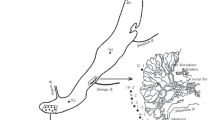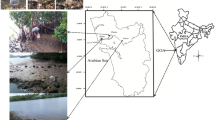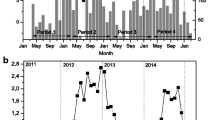Abstract
Data on the distribution of methane concentration in water in the open water area and the northern end of Lake Baikal and in the source of the Angara R. collected in September 2016 and 2019 are analyzed. To apply correlation analysis, in addition to methane, various hydrochemical characteristics were also determined, including the temperature, pH, the concentrations of О2, suspended matter, Corg, Norg, Porg, mineral compounds of nitrogen and phosphorus. Methane concentration in Baikal water in 2016 varied within 0.44–3.41 µL/dm3 (on the average, 0.80 µL/dm3); in 2019, within 0.20–5.19 µL/dm3 (on the average, 1.22 µL/dm3). The maximal methane concentration was recorded in the water mass of the deepest central depression of the lake, and the minimal, in its southern depression. Among shallow areas, minimal methane concentrations were recorded in the coastal zone of Listvenichnyi Bay, and its maximal concentrations, in the northern part of the lake, into which many rivers empty, as well as in Selenginskoe shallows. Most stations, either deep-water or shallow, showed a peak of subsurface maximum of methane concentration at depths of 25–50 m (thermocline zone), after which its concentrations commonly dropped, reaching their minimal values either in the intermediate water mass or in bottom layers. Shallow areas, in addition to higher methane concentrations compared to deep-water areas, also featured a higher contrast in its vertical distribution in the water mass. The analysis of correlation relationships between the examined hydrochemical characteristics revealed significant direct correlations of methane concentration with the concentrations of Corg and Norg and an inverse correlation with O2 concentrations.



Similar content being viewed by others
REFERENCES
Gar’kusha, D.N. and Fedorov, Yu.A. Distribution of methane concentration in coastal areas of the Gulf of Petrozavodsk, Lake Onega, Water Resour., 2015, vol. 42, no. 3, pp. 331–339.
Gar’kusha, D.N. and Fedorov, Yu.A., Faktory formirovaniya kontsentratsii metana v vodnykh ekosistemakh (The Factors that Govern Methane Concentration Formation in Aquatic Ecosystems), Rostov-on-Don, Taganrog: Izd. Yuzhn. Federal. Univ., 2021.
Gar’kusha, D.N., Fedorov, Yu.A., Tambieva, N.S., Andreev, Yu.A., and Mikhailenko, O.A., Methane in water and bottom sediments of Lake Baikal, Water Resour., 2019, vol. 46, no. 5, pp. 726–737.
Geodekyan, A.A., Avilov, V.I., and Avilova, S.D., Geoenvironmental studies of Baikal, Dokl. Akad. Nauk SSSR, 1990, vol. 310, no. 6, pp. 1442–1446.
Gosudarstvennyi doklad “O sostoyanii ozera Baikal i merakh po ego okhrane v 2017 godu” (State Report “On the Conditions of Lake Baikal and Measures for Its Protection in 2017”), Irkutsk: KTs Ekspert, 2018.
Granin, N.G., Mizandrontsev, I.B., Kozlov, V.V., Tsvetova, E.A., Gnatovskii, R.Yu., Blinov, V.V., Aslamov, I.A., Kucher, K.M., Ivanov, V.G., and Zh-danov, A.A., Ring structure on the ice cover of Lake Baikal: analysis of experimental data and mathematical modeling, Geol. Geofiz., 2018, vol. 59, no. 11, pp. 1890–1903.
Granin, N.G., Mizandrontsev, I.B., Obzhirov, A.I., Vereshchagina, O.F., Gnatovskii, R.Yu., and Zhdanov, A.A., Oxidation of methane in the water column of Lake Baikal, Dokl. Earth Sci., 2013, vol. 451, part 1, pp. 784–786.
Dagurova, O.P., Namsaraev, B.B., Kozyreva, L.P., Zemskaya, T.I., and Dulov L.E., Bacterial processes of the methane cycle in bottom sediments of Lake Baikal, Microbiology, 2004, vol. 73, no. 2, pp. 202–210.
Zhizhchenko, B.P., Uglevodorodnye gazy (Hydrocarbon Gases), Moscow: Nedra, 1984.
Zakharenko, A.S., Pimenov, N.V., Ivanov, V.G., and Zemskaya, T.I., Detection of methane in the water column at gas and oil seep sites in central and southern Lake Baikal, Microbiology, 2015, vol. 84, no. 1, pp. 90–97.
Kiprushina, K.N., Seasonal dynamics of zooplankton vertical distribution in the open part of the Southern Baikal (Bol’shie Koty region), Izv. Irkutsk. Gos. Univ., Ser. Biol., Ekol., 2009, vol. 2, no. 1, pp. 39–44.
Kuz’min, M.M., Kalmychkov, G.V., Geletii, V.F., Gniluish, V.A., Goreglyad, A.V., Khakhaev, B.N., Pevzner, L.A., Kavai, L., Ioshida, N., Luchkov, A.D., Ponomarchuk, V.A., Kontorovich, A.E., Bazhin, N.M., Makhov, G.A., Dyadin, Yu.A., Kuznetsov, F.A., Larionov, E.G., Manakov, A.Yu., Smolyakov, B.S., Mandel’baum, M.M., and Zheleznyakov, N.K., The first find of gas-hydrates in the sedimentary rocks of Lake Baikal, Dokl. Earth Sci., 1998, vol. 362, no. 7, pp. 1029–1031.
Lein, A.Yu. and Ivanov, M.V., Biogeokhimicheskii tsikl metana v okeane (Biogeochemical Cycle of Methane in the Ocean), Moscow: Nauka, 2009.
Lut, B.F., Geomorphology of Baikal Region and Lake Baikal Depression, Extended Abstract of Doct. Sci. (Geogr.) Dissertation, Irkutsk: Inst. Geol. Geophys., Sib. Branch, USSR Acad. Sci., Irkutsk, 1988, p. 32.
Makarov, M.M., Methane bubble releases from Baikal bottom sediments, Extended Abstract of of Cand. Sci. (Geogr.) Dissertation, POI FEB RAS, Irkutsk, 2016, p. 24.
Mizandrontsev, I.B., Kozlov, V.V., Ivanov, V.G., Kucher, K.M., Korneva, E.S., and Granin, N.G., Vertical distribution of methane in Baikal water, Water Resour., 2020, vol. 47, no. 1, pp. 122–129.
Namsaraev, B.B., Dulov, L.E., Sokolova, E.N., and Zemskaya, T.I., Bacterial methane production in Baikal Lake bottom sediments, Mikrobiologiya, 1995, vol. 64, no. 3, pp. 411–417.
Pestunov, D.A., Domysheva, V.M., Ivanov, V.G., Shamrin, A.M., and Panchenko, M.V., Spatial distribution of the direction of CO2 and CH4 fluxes over Baikal Lake water area (Around-Baikal Expedition, June, 2013), Opt. Atmos. Okeana, 2015, vol. 28, no. 9, pp. 792–800.
RD 52.24.512-2012 Ob’’emnaya kontsentratsiya metana v vodakh. Metodika izmerenii gazokhromatograficheskim metodom s ispol’zovaniem analiza ravnovesnogo para (Bulk Concentration of Methane in Water. Procedure of Measurement by Gas-Chromatographic Method with the Use of Equilibrium Vapor Analysis), Rostov-on-Don: Rosgidromet, Gidrokhem. Inst., 2012.
Rukovodstvo po khimicheskomu analizu poverkhnostnykh vod sushi (Guide for Chemical Analysis of Continental Surface Water), Boeva, L.V, Ed., Rostov-on-Don: NOK, 2009.
Fedorov, Yu.A., Nikanorov, A.M., and Tambieva, N.S., First data on the biogenic methane distribution in water and bottom sediments of Lake Baikal, Dokl. Earth Sci., 1997, vol. 353A, no. 3, pp. 424–426.
Fedorov, Yu.A., Tambieva, N.S., and Gar’kusha, D.N., Effect of natural and anthropogenic factors and processes on methane concentration distribution in water and bottom sediments of Lake Ladoga, Geoekol., Inzh. Geol., Gidrogeol., Geokriol., 2006, no. 5, pp. 412–424.
Fedorov, Yu.A., Tambieva, N.S., and Gar’kusha, D.N., Methane as an indicator to the environmental conditions of freshwater bodies: case study of lakes Valdai and Uzhin, Meteorol Gidrol., 2004, no. 6, pp. 88–96.
Fedorov, Yu.A., Stabil’nye izotopy i evolyutsiya gidrosfery (Stable Isotopes and Hydrosphere Evolution), Moscow: Tsentr “Istina” MO RF, 1999.
Shimaraev, M.N., Troitskaya, E.S., and Gnatovskii, R.Yu., Variations of deep-water temperature in Lake Baikal in 1972–2007, Geogr. Prir. Resur., 2009, no. 3, pp. 68–76.
Bianchi, M., Marty, D., Teyssie, J.-L., and Fowler, S.W., Strictly aerobic and anaerobic bacteria associated with sinking particulate matter and zooplankton fecal pellets, Mar. Ecol. Progress Ser., 1992, vol. 88, pp. 55–60.
Conrad, R., The global methane cycle: recent advances in understanding the microbial processes involved, Environ. Microbial, 2009, Rep. 1, pp. 285–292.
Cynar, F.J. and Yayanos, A.A., Enrichment and characterization of methanogenic bacterium from the oxic upper layer of the ocean, Curr. Microbiol., 1991, vol. 23, pp. 89–96.
Damm, E., Helmke, E., Thoms, S., Schauer, U., Nothig, E., Bakker, K., and Kiene, R.P., Methane production in aerobic surface water in central arctic ocean, Biogeosci., 2010, vol. 7, pp. 1099–1108.
Granin, N.G., Makarov, M.M., Kucher, K.M., and Gnatovsky, R.Y., Gas seeps in Lake Baikal—detection, distribution, and implications for water column mixing, Geo-Mar. Lett., 2010, vol. 30, nos. 3, 4, pp. 399–409.
Granin, N.G., Radzyminovich, N.A., Granina, L.Z., Blinov, V.V., and Gnatovsky, R.Yu., Freshening of near-bottom waters in Lake Baikal triggered by the Mw6. 2 Kultuk earthquake of August 2008, Geo-Mar. Lett., 2012, vol. 32, no. 5, pp. 453–464.
Grossart, H.-P., Frindte, K., Dziallas, C., et al., Microbial methane production in oxygenated water column of an oligotrophic lake, Proc. Natl. Acad. Sci. U.S.A., 2011, vol. 108, pp. 19657–19661.
Izmest’eva, L.R., Moore, M.V., Hampton, S.E., Ferwerda, C.J., Gray, D.K., Woo, K.H., Pislegina, H.V., Krashchuk, L.S., Shimaraeva, S.V., and Silow, E.A., Lake-wide physical and biological trends associated with warming in Lake Baikal, J. Great Lakes Res., 2016, vol. 42, pp. 6–17.
Kadnikov, V.V., Mardanov, A.V., Beletsky, A.V., Shubenkova, O.V., Pogodaeva, T.V., Zemskaya, T.I., Ravin, N.V., and Skryabin, K.G., Microbial community structure in methane hydrate-bearing sediments of freshwater Lake Baikal, Federation Eur. Microbiol. Soc. Microbiol. Ecol., 2012, vol. 79, pp. 348–358.
Karl, D.N., Beversdorf, L., Bjorkman, K.M., Church, M.J., Martinez, A., and Delong, E.F., Aerobic production of methane in the sea, Nat. Geosci., 2008, vol. 1, pp. 473–478.
Khlystov, O., De Batist, M., Shoji, H., Hachikubo, A., Nishio, S., Naudts, L., Poort, J., Khabuev, A., Belousov, O., Manakov, A., and Kalmychkov, G., Gas hydrate of Lake Baikal: discovery and varieties, Asian Earth Sci., 2013, vol. 62, no. 1, pp. 162–166.
Leifer, I., Boles, J.R., Luyendyk, B.P., and Clark, J.F., Transient discharges from marine hydrocarbon seeps: spatial and temporal variability, Environ. Geol., 2004, vol. 46, no. 8, pp. 1038–1052.
Murase, J. and Sugimoto, A., Inhibitory effect of light on methane oxidation in pelagic water column of a mesotrophic lake (Lake Biwa, Japan), Limnol. Oceanogr., 2005, vol. 50, pp. 1339–1343.
Potyomkina, T.G., Baryshev, V.B., Grachev, A.M., and Potyomkin, V.L., Chemical composition of suspension in water body of Lake Baikal, Nucl. Instr. Meth. Phys. Res. A, 1998, vol. 405, pp. 543–545.
Reeburgh, W.S., Oceanic methane biogeochemistry, Chem. Rev., 2007, vol. 107, pp. 486–513.
Schmale, O., Greinert, J., and Rehder, G., Methane emission from high-intensity marine gas seeps in the Black Sea into the atmosphere, Geophys. Rev. Lett., 2005, vol. 32, no. 7, p. L07609.
Granin, N.G., Kapitanov, V.A., McGinnis, D.F., Mizandrontsev, I.B., Obzhirov, A.I., and Wiiest, A., Sources and sinks of methane in Lake Baikal: a synthesis of measurements and modeling, Limnol. Oceanogr., 2007, vol. 52, no. 5, pp. 1824–1837.
Tang, K.W., McGinnis, D.F., Frindte, K., Bruchert, V., and Grossart, H.-P., Paradox reconsidered: methane oversaturation in well-oxygenated lake waters, Limnol. Oceanogr., 2014, vol. 59, no. 1, pp. 275–284.
Zemskaya, T., Egorov, A., Khlystov, O., Shubenkova, O., Namsaraev, B., Chernitsina, S., Dagurova, O., Kalmychkov, G., and Grachev, M., Biogeochemical cycles of methane in Lake Baikal, Geoph. Res. Abstr., 2005, vol. 7, p. 03994.
Funding
This study was supported by the Russian Science Foundation, project 22-27-00671 in the Southern Federal University.
Author information
Authors and Affiliations
Corresponding author
Rights and permissions
About this article
Cite this article
Gar’kusha, D.N., Fedorov, Y.A., Tambieva, N.S. et al. Methane Distribution in Lake Baikal Water. Water Resour 50, 400–414 (2023). https://doi.org/10.1134/S0097807823020094
Received:
Revised:
Accepted:
Published:
Issue Date:
DOI: https://doi.org/10.1134/S0097807823020094




